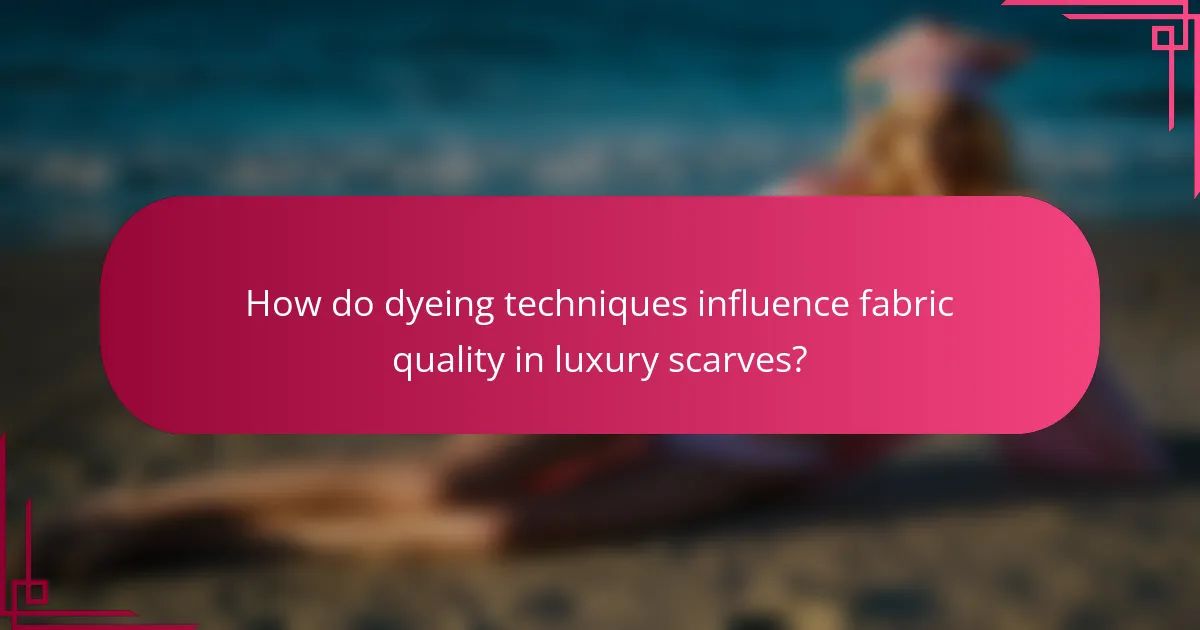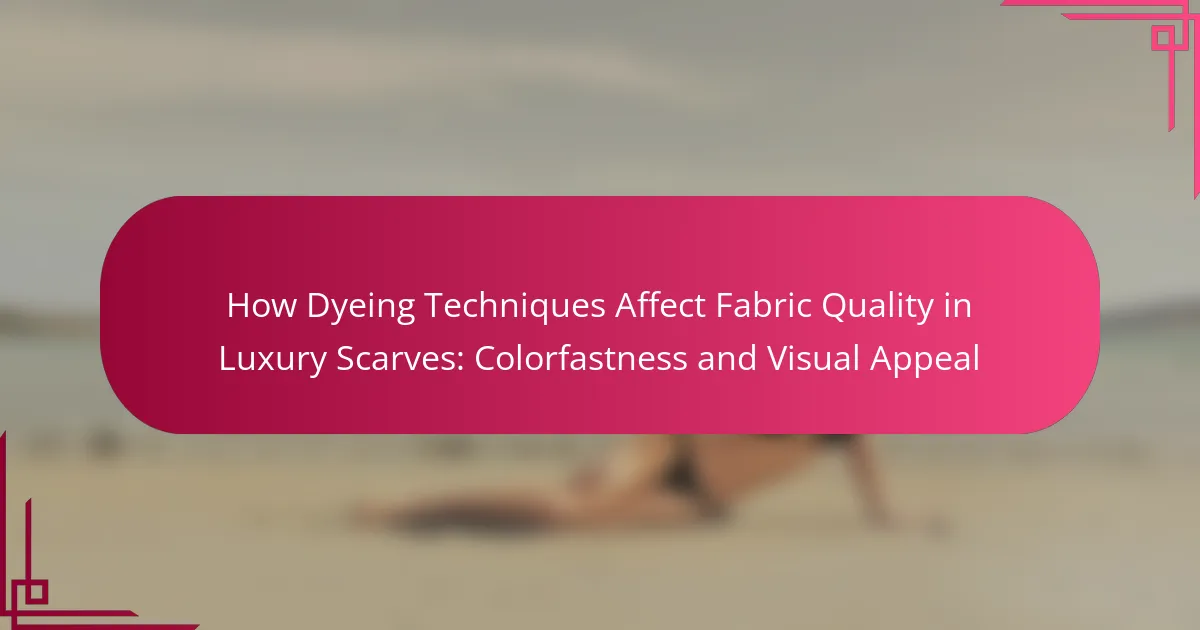The article explores the impact of dyeing techniques on the fabric quality of luxury scarves, focusing on colorfastness and visual appeal. It examines various methods, including natural dyeing and digital printing, highlighting how these techniques influence color retention and the overall texture of the fabric. Natural dyes are noted for their ability to deeply penetrate fibers, resulting in vibrant and long-lasting colors, while synthetic dyes offer a broader color palette but may lack depth. The discussion also covers how application methods, such as immersion dyeing and surface printing, affect the softness and feel of the scarves. Overall, the article emphasizes that high-quality dyeing techniques are essential for maintaining the aesthetic and durability of luxury scarves over time.

How do dyeing techniques influence fabric quality in luxury scarves?
Dyeing techniques significantly influence fabric quality in luxury scarves. Techniques such as natural dyeing and digital printing enhance colorfastness. Natural dyes often penetrate fibers deeply, resulting in vibrant, long-lasting colors. Synthetic dyes can provide a wider color range but may lack the same depth. The method of application also affects texture; immersion dyeing can soften fibers, while surface printing maintains original fabric feel. High-quality dyeing techniques ensure that scarves resist fading and maintain their visual appeal over time. Research shows that scarves dyed with high-quality methods retain color and texture better than those using inferior techniques.
What are the primary dyeing techniques used for luxury scarves?
The primary dyeing techniques used for luxury scarves include silk screen printing, digital printing, and tie-dyeing. Silk screen printing involves applying dye through a mesh screen, allowing for vibrant colors and intricate designs. Digital printing uses inkjet technology to print directly onto fabric, enabling detailed patterns and color gradation. Tie-dyeing creates unique patterns by folding and binding fabric before applying dye, resulting in a distinctive appearance. Each technique affects the fabric’s quality and visual appeal, influencing colorfastness and overall aesthetics.
How does the dyeing process impact the texture of the fabric?
The dyeing process can significantly alter the texture of fabric. Different dyeing techniques can lead to variations in softness, stiffness, and overall feel. For instance, reactive dyeing often results in a softer texture due to the chemical bonding with the fibers. Conversely, some synthetic dyes may create a stiffer feel, affecting drape and comfort. Additionally, the temperature and duration of the dyeing process can influence texture; higher temperatures may cause fibers to swell or shrink. Fabrics like silk may become more lustrous and smooth after dyeing, enhancing their luxurious feel. In contrast, cotton may retain a more natural texture. Overall, the dyeing process is crucial in determining the final tactile experience of the fabric.
What role does dyeing play in the durability of luxury scarves?
Dyeing plays a crucial role in the durability of luxury scarves. It affects colorfastness, which is the ability of the dye to resist fading over time. High-quality dyes and proper dyeing techniques enhance the fabric’s resistance to wear and tear. For instance, natural dyes often penetrate fibers deeply, providing better longevity than synthetic alternatives. Additionally, well-dyed scarves maintain their visual appeal longer, as vibrant colors do not wash out easily. This preservation of color contributes to the overall durability of the scarf. Studies have shown that scarves dyed with high-quality methods can last significantly longer than those dyed poorly.
Why is colorfastness important in luxury scarf production?
Colorfastness is crucial in luxury scarf production because it ensures that dyes remain vibrant and do not fade over time. High colorfastness enhances the aesthetic appeal of the scarf, maintaining its visual quality. Consumers expect luxury items to retain their beauty after repeated use and washing. Fabrics with poor colorfastness can lead to dissatisfaction and reduced brand reputation. According to a study by the American Association of Textile Chemists and Colorists, colorfastness significantly impacts consumer perception of quality. Therefore, achieving high colorfastness is essential for meeting luxury market standards.
What factors affect colorfastness in dyed fabrics?
Colorfastness in dyed fabrics is affected by several factors. The type of dye used plays a significant role. Reactive dyes generally offer better colorfastness compared to direct dyes. The fabric composition also influences color retention. Natural fibers like cotton may fade more than synthetic fibers like polyester.
The dyeing process, including temperature and duration, impacts color stability. Higher temperatures can enhance dye [censured] but may also increase fading. Additionally, exposure to light, particularly UV rays, can degrade colors over time.
Washing conditions are crucial as well. Detergents and water temperature can lead to color loss. Lastly, the presence of mordants can improve colorfastness by helping dyes bond more effectively to fibers.
How can manufacturers ensure colorfastness in their scarves?
Manufacturers can ensure colorfastness in their scarves by selecting high-quality dyes and using appropriate dyeing techniques. Using reactive dyes can enhance color adherence to fibers. Pre-treating fabrics with mordants can improve dye fixation. Manufacturers should also conduct wash and lightfastness tests to confirm durability. Implementing proper finishing processes can further lock in colors. Regular quality checks during production help maintain standards. Research by the American Association of Textile Chemists and Colorists supports these methods for effective colorfastness.
What visual appeal do different dyeing techniques offer?
Different dyeing techniques offer unique visual appeals that enhance fabric aesthetics. Techniques like tie-dye create vibrant, irregular patterns that attract attention. Batik provides intricate designs with a rich cultural heritage, often featuring detailed motifs. Shibori results in organic shapes and textures, offering a handcrafted look. Screen printing allows for bold graphics and precise designs, ideal for modern aesthetics. Natural dyeing produces soft, earthy tones that appeal to eco-conscious consumers. Each technique contributes distinct visual characteristics, making luxury scarves visually diverse and appealing.
How do various dyeing methods enhance the aesthetic qualities of scarves?
Various dyeing methods enhance the aesthetic qualities of scarves by introducing vibrant colors and intricate patterns. Techniques such as tie-dye, batik, and digital printing allow for unique visual effects. For instance, tie-dye creates organic, unpredictable patterns that add character. Batik involves wax-resist dyeing, resulting in detailed designs that are visually striking. Digital printing enables high-resolution images and complex designs that traditional methods cannot achieve. These methods influence how light interacts with the fabric, enhancing depth and texture. The choice of dye can also affect the fabric’s sheen and overall appearance. In summary, diverse dyeing techniques significantly elevate the visual appeal of scarves through color and design innovation.
What are the trends in color application for luxury scarves?
Current trends in color application for luxury scarves emphasize bold, vibrant hues and intricate patterns. Designers are increasingly favoring rich jewel tones, such as emerald green and sapphire blue. Pastel shades are also gaining popularity for a softer, more delicate look. Gradient and ombre effects are prevalent, creating a dynamic visual appeal. Additionally, tie-dye techniques are making a comeback, offering a unique artisanal touch. Sustainable dyeing methods are becoming essential, reflecting consumer demand for eco-friendly products. Colorfastness remains a priority, ensuring that the vibrancy lasts over time. These trends highlight the intersection of aesthetic appeal and quality in luxury scarf design.
How do dyeing techniques affect the overall consumer experience?
Dyeing techniques significantly influence the overall consumer experience by affecting fabric quality, colorfastness, and visual appeal. High-quality dyeing methods enhance the vibrancy and longevity of colors in luxury scarves. For instance, techniques like reactive dyeing create strong chemical bonds with fibers, resulting in superior color retention. This ensures that consumers enjoy their scarves without fading over time. Furthermore, the choice of dyeing technique can impact the texture and feel of the fabric. Consumers often prefer scarves that not only look good but also feel luxurious against the skin. In summary, effective dyeing techniques directly contribute to consumer satisfaction by ensuring durability and aesthetic appeal in luxury scarves.
What are the implications of dyeing techniques on luxury scarf care?
Dyeing techniques significantly impact luxury scarf care. Various methods, such as natural, synthetic, and tie-dye, influence color retention. For instance, natural dyes often result in less colorfastness compared to synthetic dyes. This can lead to fading and discoloration with improper care. Additionally, certain dyeing processes may require specific cleaning methods. For example, scarves dyed with reactive dyes may tolerate water-based cleaning better. Conversely, those dyed with direct dyes may need dry cleaning to preserve color integrity. Understanding these implications helps in maintaining the scarf’s appearance and longevity. Thus, selecting the appropriate care method based on dyeing technique is essential for luxury scarf maintenance.
How should consumers care for dyed luxury scarves to maintain quality?
Consumers should care for dyed luxury scarves by following specific maintenance practices. Hand washing in cold water with mild detergent is recommended. Avoid using bleach or harsh chemicals to prevent color fading. Air drying is preferable; lay the scarf flat on a clean surface. Direct sunlight should be avoided to maintain color vibrancy. Storing scarves in a cool, dry place helps prevent damage. Wrapping them in acid-free tissue paper can protect against dust and light exposure. Regular gentle steaming can remove wrinkles without harming the fabric. These practices help preserve the quality and appearance of dyed luxury scarves.
What best practices should be followed in selecting dyed luxury scarves?
Select dyed luxury scarves by considering fabric quality, dye techniques, and colorfastness. High-quality fabrics like silk or cashmere enhance the scarf’s luxury feel. Look for natural dyeing methods, as they often yield richer colors and better fabric integrity. Check for colorfastness by ensuring the dye does not bleed when wet. Evaluate the visual appeal by assessing color vibrancy and pattern consistency. Choose scarves with detailed craftsmanship, as this reflects higher quality. Inspect the edges for clean finishes, indicating attention to detail. Always buy from reputable brands known for their dyeing processes. These practices ensure a beautiful and durable luxury scarf.
The main entity of this article is luxury scarves, specifically focusing on how dyeing techniques influence their fabric quality, colorfastness, and visual appeal. The article examines various dyeing methods, including natural dyeing, digital printing, and silk screen printing, highlighting their effects on color retention, texture, and overall aesthetics. It also discusses the importance of colorfastness in maintaining the quality and longevity of luxury scarves, alongside care practices that consumers should follow to preserve these attributes. Additionally, the article outlines current trends in color application and the implications of dyeing techniques on consumer experience and scarf maintenance.
